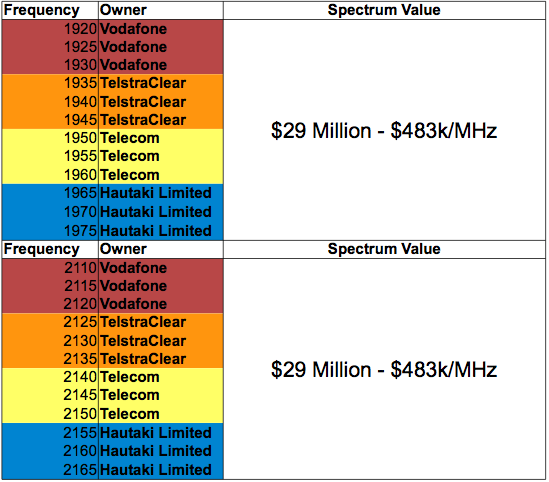Radio Spectrum in New Zealand is allocated for a number of uses, including broadcast, narrow-band radio communications, point to point linking, and cellular, to name a few. Cellular spectrum in New Zealand is auctioned on the basis of blocks of a particular frequency range that is exclusive for the use of an operator across the entire country. These blocks are awarded on twenty year terms that appreciate the huge capital expenditure and time commitments involved in building national cellular networks.
Some carriers have dedicated an immense amount of resources to the acquisition of prime spectrum in New Zealand, while others have taken a value for money approach to acquisition. The following chart shows the amount of national spectrum licensed in megahertz (MHz), and the approximate aggregate dollar value of that spectrum (in Q3 2010 dollars), on a per-carrier basis.
Note in the chart above that some carriers have a lot of spectrum with very little cash value. In the eyes of the market, all spectrum is not created equal. The next chart shows the value of spectrum, on a block average price per MHz. All prices are for 20 year rights. The trend shows that the lower the radio frequency, the higher the value. The market appreciates that lower spectrum has higher performance characteristics. The price/performance exception in the chart is 2.1GHz, which is “paired” with 1.9GHz when used for 3G services – i.e. one does not work without the other.
The set of charts below show all of the cellular spectrum allocations broken down into approximate 5MHz blocks, with a manager (telecommunications carrier) and value attached to spectrum blocks – per megahertz of spectrum. The values below (and above) have been calculated based on the auction price of the spectrum blocks, normalized in to Q3 2010 dollars using the RBNZ Inflation Calculator. Prices are averaged per block, and blocks are shown with managers as of March 2011. No secondary market purchases, enforced divestitures, or spectrum swaps have been taken in to account, however such situations affect a very small number of blocks overall.
The 800 & 900MHz frequency bands are used by Telecom and Vodafone to provide advanced 3G services, and by 2degrees to provide 2.5G cellular services. These frequencies have attracted the highest prices at auction of any that have sold in New Zealand. Some of the high prices can be attributed to the state of the economy in 2001, but as shown in an Ovum study for the Canadian Wireless Telecommunications Association, multiple markets throughout the world consider 900MHz spectrum to have twice the value of 1800MHz spectrum, as indicated in the value per MHz chart above.
The 1700 & 1800MHz frequency bands are paired transmit/receive with 95MHz separation, with a small TDD block in the middle. They are used by Vodafone and 2degrees to provide 2.5G Cellular services. Telecom formerly used this band for its CDMA network, including EVDO 1x data services.
The 1900 & 2100MHz (also referred to as 1.9 & 2.1GHz) frequency bands are paired transmit/receive with 190MHz separation. They are used by Vodafone, Telecom, and 2degrees for providing 3G services to small coverage areas – with a typical coverage radius of less than 5km. TelstraClear briefly applied their spectrum to a trial in Tauranga in 2006 and 2007, but shut the service down due to a dispute with Vodafone over roaming charges.

At 2GHz Woosh operates a TD-CDMA cellular data system supplied by equipment vendor IPWireless. The band has little hardware available, and has not been used by Vodafone, TelstraClear, or Kordia.
At 2.2GHz Kordia operates a TDD wireless system supplied by equipement vendor Airspan. The system, commercially called Extend, is used to provide fixed rural wireless access.

The 2.3 and 2.5GHz bands were auctioned in late 2007, and were originally intended for Mobile WiMAX (TDD blocks) and cellular expansion (FDD blocks). Since 2010, TDD Long Term Evolution (LTE) systems have been developed for some of these frequencies, and it is likely that most systems in these bands will be LTE. As of March 2011, no systems were licensed in the 2.3GHz band, however a number of regional providers had begun to license systems in a Crown “managed spectrum park” in the 2.5GHz band.





